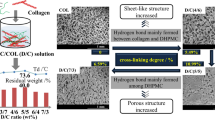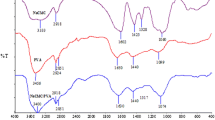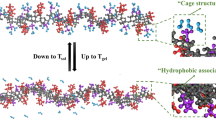Abstract
Hydrogel materials based on bio-degradable polymers have received a lot of interest owing to many potential applications. In this study, hydroxypropyl methylcellulose (HPMC) as a based polymer was cross-linked using 5 wt% of non-toxic citric acid. Polyethylene glycol (PEG) and glycerol were used as gelation accelerants. The effect of reaction temperature on the ability to cross-link the matrix was investigated using differential scanning calorimetry (DSC), thermogravimetric (TGA), and dynamic mechanical analysis (DMA). The cross-linking process could not be observed using DSC or TGA. However, the sample with PEG and glycerol exhibited the highest increase of storage modulus in DMA measurement. A completely gelled state (100% gel fraction) could be obtained in all sample types at the temperature of 140 °C for 10 h. The addition of PEG significantly improved the gel fraction of HPMC-based hydrogel. With a higher concentration of PEG, the increase of C = O groups which were a result of the esterification of citric acid and HPMC molecule was confirmed by Fourier transform infrared spectroscopy (FTIR). The sample with 1 wt% of PEG showed the highest methylene blue adsorption.










Similar content being viewed by others
References
Guilherme MR, Aouada FA, Fajardo AR, Martins AF, Paulino AT, Davi MFT et al (2015) Superabsorbent hydrogels based on polysaccharides for application in agriculture as soil conditioner and nutrient carrier: A review. Eur Polymer J 72:365–385. https://doi.org/10.1016/j.eurpolymj.2015.04.017
Hamidi M, Azadi A, Rafiei P (2008) Hydrogel nanoparticles in drug delivery. Adv Drug Deliv Rev 60(15):1638–1649. https://doi.org/10.1016/j.addr.2008.08.002
Sikareepaisan P, Ruktanonchai U, Supaphol P (2011) Preparation and characterization of asiaticoside-loaded alginate films and their potential for use as effectual wound dressings. Carbohyd Polym 83(4):1457–1469. https://doi.org/10.1016/j.carbpol.2010.09.048
Hassan CM, Peppas NA. (2000) Structure and Applications of Poly(vinyl alcohol) Hydrogels Produced by Conventional Crosslinking or by Freezing/Thawing Methods. Biopolymers · PVA Hydrogels, Anionic Polymerisation Nanocomposites. Berlin, Heidelberg: Springer Berlin Heidelberg. p. 37–65.
Sennakesavan G, Mostakhdemin M, Dkhar LK, Seyfoddin A, Fatihhi SJ (2020) Acrylic acid/acrylamide based hydrogels and its properties - a review. Polym Degrad Stab 180:109308. https://doi.org/10.1016/j.polymdegradstab.2020.109308
Ambrosio L, Demitri C, Sannino A (2011) 2 - Superabsorbent cellulose-based hydrogels for biomedical applications. In: Rimmer S (ed) Biomedical Hydrogels. Woodhead Publishing, pp 25–50
Chang C, Zhang L (2011) Cellulose-based hydrogels: present status and application prospects. Carbohyd Polym 84(1):40–53. https://doi.org/10.1016/j.carbpol.2010.12.023
Zainal SH, Mohd NH, Suhaili N, Anuar FH, Lazim AM, Othaman R (2021) Preparation of cellulose-based hydrogel: a review. J Market Res 10:935–952. https://doi.org/10.1016/j.jmrt.2020.12.012
Ciolacu DE, Suflet DM. (2018) 11 - Cellulose-Based Hydrogels for Medical/Pharmaceutical Applications. In: Popa V, Volf I, editors. Biomass as Renewable Raw Material to Obtain Bioproducts of High-Tech Value. Elsevier. p. 401–39.
te Nijenhuis K (2007) On the nature of crosslinks in thermoreversible gels. Polym Bull 58(1):27–42. https://doi.org/10.1007/s00289-006-0610-7
Vinatier C, Magne D, Moreau A, Gauthier O, Malard O, Vignes-Colombeix C et al (2007) Engineering cartilage with human nasal chondrocytes and a silanized hydroxypropyl methylcellulose hydrogel. J Biomed Mater Res, Part A 80A(1):66–74. https://doi.org/10.1002/jbm.a.30867
Kono H, Fujita S (2012) Biodegradable superabsorbent hydrogels derived from cellulose by esterification crosslinking with 1,2,3,4-butanetetracarboxylic dianhydride. Carbohyd Polym 87(4):2582–2588. https://doi.org/10.1016/j.carbpol.2011.11.045
Yoshimura T, Matsuo K, Fujioka R (2006) Novel biodegradable superabsorbent hydrogels derived from cotton cellulose and succinic anhydride: Synthesis and characterization. J Appl Polym Sci 99(6):3251–3256. https://doi.org/10.1002/app.22794
Sannino A, Madaghiele M, Conversano F, Mele G, Maffezzoli A, Netti PA et al (2004) Cellulose derivative−hyaluronic acid-based microporous hydrogels cross-linked through divinyl sulfone (DVS) to modulate equilibrium sorption capacity and network stability. Biomacromol 5(1):92–96. https://doi.org/10.1021/bm0341881
Udoetok IA, Dimmick RM, Wilson LD, Headley JV (2016) Adsorption properties of cross-linked cellulose-epichlorohydrin polymers in aqueous solution. Carbohyd Polym 136:329–340. https://doi.org/10.1016/j.carbpol.2015.09.032
Demitri C, Del Sole R, Scalera F, Sannino A, Vasapollo G, Maffezzoli A et al (2008) Novel superabsorbent cellulose-based hydrogels crosslinked with citric acid. J Appl Polym Sci 110(4):2453–2460. https://doi.org/10.1002/app.28660
Capanema NSV, Mansur AAP, de Jesus AC, Carvalho SM, de Oliveira LC, Mansur HS (2018) Superabsorbent crosslinked carboxymethyl cellulose-PEG hydrogels for potential wound dressing applications. Int J Biol Macromol 106:1218–1234. https://doi.org/10.1016/j.ijbiomac.2017.08.124
Burdock GA (2007) Safety assessment of hydroxypropyl methylcellulose as a food ingredient. Food Chem Toxicol 45(12):2341–2351. https://doi.org/10.1016/j.fct.2007.07.011
Kaur G, Grewal J, Jyoti K, Jain UK, Chandra R, Madan J (2018) Oral controlled and sustained drug delivery systems. Drug Targeting and Stimuli Sensitive Drug Delivery Systems. Elsevier, pp 567–626. https://doi.org/10.1016/B978-0-12-813689-8.00015-X
Joshi SC (2011) Sol-gel behavior of hydroxypropyl methylcellulose (HPMC) in ionic media including drug release. Materials (Basel) 4(10):1861–1905. https://doi.org/10.3390/ma4101861
Perez-Robles S, Carotenuto C, Minale M (2022) HPMC Hydrogel formation mechanisms unveiled by the evaluation of the activation energy. Polymers. https://doi.org/10.3390/polym14030635
Nie S, Pan W, Li X, Wu X (2004) The effect of citric acid added to hydroxypropyl methylcellulose (HPMC) matrix tablets on the release profile of vinpocetine. Drug Dev Ind Pharm 30(6):627–635. https://doi.org/10.1081/DDC-120037664
Marani PL, Bloisi GD, Petri DFS (2015) Hydroxypropylmethyl cellulose films crosslinked with citric acid for control release of nicotine. Cellulose 22(6):3907–3918. https://doi.org/10.1007/s10570-015-0757-1
Lagergren SK (1898) About the theory of so-called adsorption of Soluble substances. Sven Vetenskapsakad Handingarl 24:1–39
Gómez-Carracedo A, Alvarez-Lorenzo C, Gómez-Amoza JL, Concheiro A (2003) Chemical structure and glass transition temperature of non-ionic cellulose ethers. J Therm Anal Calorim 73(2):587–596. https://doi.org/10.1023/A:1025434314396
Akinosho H, Hawkins S, Wicker L (2013) Hydroxypropyl methylcellulose substituent analysis and rheological properties. Carbohyd Polym 98(1):276–281. https://doi.org/10.1016/j.carbpol.2013.05.081
Bashir S, Zafar N, Lebaz N, Mahmood A, Elaissari A (2020) Hydroxypropyl methylcellulose-based hydrogel copolymeric for controlled delivery of galantamine hydrobromide in dementia. Processes 8(11):1350. https://doi.org/10.3390/pr8111350
Wang J, Guo X (2020) Adsorption kinetic models: physical meanings, applications, and solving methods. J Hazard Mater 390:122156. https://doi.org/10.1016/j.jhazmat.2020.122156
Uliniuc A, Hamaide T, Popa M, Băcăiță S (2013) Modified starch-based hydrogels cross-linked with citric acid and their use as drug delivery systems for levofloxacin. Soft Mater 11(4):483–493. https://doi.org/10.1080/1539445X.2012.710698
Xie X, Liu Q (2004) Development and physicochemical characterization of new resistant citrate starch from different corn Starches. Starch - Stärke 56(8):364–370. https://doi.org/10.1002/star.200300261
Author information
Authors and Affiliations
Corresponding author
Ethics declarations
Conflict of interest
The authors have no competing interests to declare that are relevant to the content of this article.
Additional information
Publisher's Note
Springer Nature remains neutral with regard to jurisdictional claims in published maps and institutional affiliations.
Supplementary Information
Below is the link to the electronic supplementary material.
Rights and permissions
Springer Nature or its licensor (e.g. a society or other partner) holds exclusive rights to this article under a publishing agreement with the author(s) or other rightsholder(s); author self-archiving of the accepted manuscript version of this article is solely governed by the terms of such publishing agreement and applicable law.
About this article
Cite this article
Giang, H.N., Le, A.T.K., Huynh, T.N.A. et al. Effect of additives on fabrication and properties of hydroxypropyl methylcellulose-based hydrogels. Polym. Bull. 80, 11121–11137 (2023). https://doi.org/10.1007/s00289-022-04610-7
Received:
Revised:
Accepted:
Published:
Issue Date:
DOI: https://doi.org/10.1007/s00289-022-04610-7




